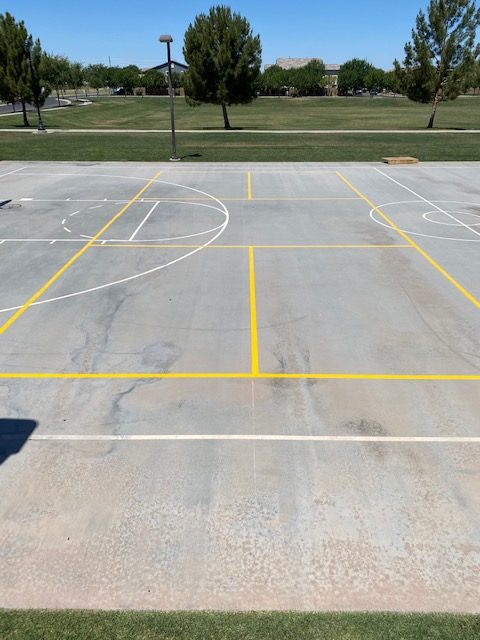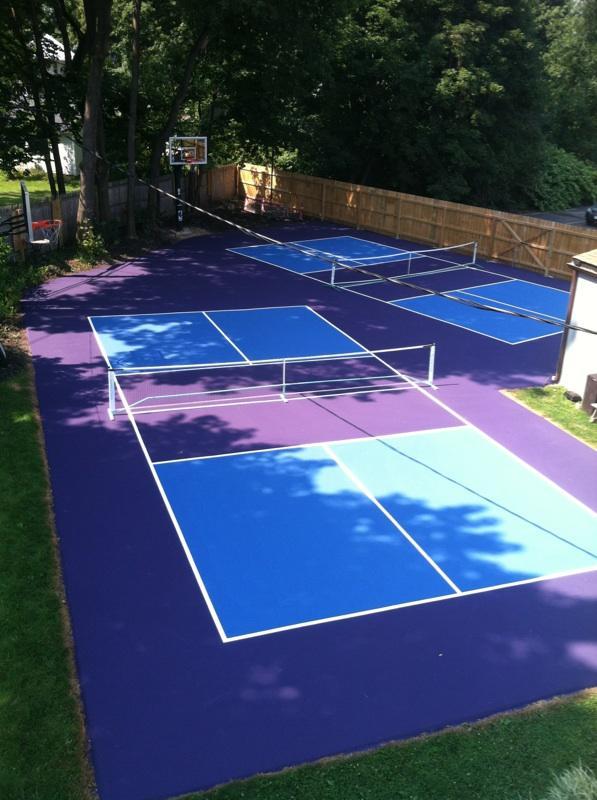Exactly How to Make Sure Quality and Long Life with a Pickleball Court Contractor
Exactly How to Make Sure Quality and Long Life with a Pickleball Court Contractor
Blog Article
A Comprehensive Overview to Creating the Perfect Pickleball Court for All Ability Degrees
Designing a pickleball court that provides to players of differing ability degrees necessitates a complex method, including important elements such as court measurements, surface products, and availability features. What specific factors to consider must be focused on to guarantee an effective implementation?

Understanding Court Capacities
Recognizing the dimensions of a pickleball court is critical for both designers and gamers, as these requirements make certain a regular and fair playing experience. A common pickleball court determines 20 feet vast by 44 feet long for both singles and increases play. The court is divided right into 2 equivalent halves by a web that stands 36 inches high at the sidelines and 34 inches at the center.
Secret attributes of the court include the non-volley area, generally referred to as the "cooking area," which extends 7 feet from the internet on both sides. This location is critical for regulating gamer movement and volleying, ensuring strategic play. Additionally, the solution areas on each side of the court are vital, determining 10 feet wide and 15 feet deep, created to accommodate proper offering methods.
Surrounding the court, a location of at least 10 feet must be assigned as the safety and security area, permitting players ample room to move and protect against injuries throughout play. Adhering to these measurements not just fosters fair competition however additionally promotes security and satisfaction for all participants, making it essential for any type of pickleball court design.
Selecting the Right Surface
The option of playing surface for a pickleball court considerably affects the game's dynamics and gamer experience. Selecting the proper product is vital for ensuring gamer security, convenience, and efficiency. Typical surface areas consist of asphalt, concrete, and specialized sporting activities floor covering.
Asphalt is a popular option as a result of its cost and toughness. It gives a consistent playing surface area but can be tough on joints over prolonged play. Concrete, while similar in longevity, uses minimal flexibility, possibly causing boosted influence on gamers' bodies.
For a more cushioned experience, many facilities choose specialized sports floor covering, such as synthetic surface areas or modular floor tiles. These materials often consist of shock-absorbing buildings, reducing the risk of injuries and improving player convenience. Such surfaces can boost sphere bounce consistency, which is crucial for reasonable play.
When picking a surface, consider factors such as climate, maintenance needs, and the intensity of play. A well-chosen surface area not only improves gameplay but also adds to the durability of the court itself. Inevitably, recognizing the subtleties of different materials will help in developing an optimal pickleball atmosphere customized to various ability levels.
Optimal Court Design
An ideal court layout is necessary for making best use of both player efficiency and viewer enjoyment in pickleball. The dimensions of a basic pickleball court are 20 feet vast by 44 feet long for increases play, maintaining a clear border that improves gameplay. The net, placed at 36 inches high at the sidelines and 34 inches in the facility, is important for keeping the characteristics of the video game.
Incorporating designated areas around the court for players anonymous to move freely is vital. A minimum of 10 feet of clearance on all sides of the court is advised to prevent collisions and offer room for spectators. Additionally, alignment plays a significant function; the court should ideally be straightened north-south to minimize the effect of sun glow on gamers throughout height hours.
Effective spectator placement is equally important. Elevated watching locations or bleachers placed behind the sidelines can enhance the experience while ensuring safety. Visible and clear court markings help in gameplay, with contrasting shades for boundaries and non-volley zones that define essential areas for gamers. On the whole, a properly designed court design fosters an engaging setting for both viewers and players.

Access Considerations
When making a pickleball court, guaranteeing accessibility for all players, including those with disabilities, is vital. An attentively designed court can promote inclusivity and encourage participation from individuals of differing capabilities.

Accessibility courses to the court need to also be very carefully planned. Ensure that pathways bring about the court are large sufficient for wheelchair customers and are Visit Website outfitted with ramps where necessary. Signage ought to be clear and large enough to be conveniently checked out.
In addition, seating areas must be created to permit for very easy access to and from the court. This consists of giving marked spaces for spectators who might have wheelchair challenges.
Lastly, make sure that toilet facilities nearby satisfy accessibility criteria. By thinking about these components, you can produce a pickleball court that is inviting and functional for every person, thus promoting a lively and varied neighborhood of players.
Maintenance and Upkeep
Correct maintenance and maintenance of a pickleball court are necessary for making certain visit this site optimal playing problems and lengthening the lifespan of the facility. Normal examinations must be conducted to recognize and deal with any kind of damages or wear, such as splits in the surface area or loose netting. These problems, if left ignored, can adversely impact gameplay and safety and security.
Surface upkeep is vital; courts must be cleaned often to get rid of debris, leaves, or dirt that can affect traction. For tough courts, periodic stress washing is suggested to keep surface stability and looks. If your court is made from softer products, such as asphalt, securing or resurfacing might be necessary to safeguard versus weather-related wear.
In addition, net elevation and stress must be examined routinely, as improper setups can change gameplay. Maintaining bordering areas, including secure fencing and illumination, is similarly vital for making certain a delightful and safe setting.
Conclusion
In verdict, the layout of an excellent pickleball court demands a precise strategy that incorporates correct measurements, suitable surface area products, and thoughtful format. By sticking to these guidelines, the best pickleball court can be created, promoting satisfaction and sports development for gamers of varying ability degrees.
Creating a pickleball court that caters to players of varying skill levels demands a multifaceted technique, including essential elements such as court dimensions, surface materials, and access features.Understanding the measurements of a pickleball court is critical for both players and developers, as these specs ensure a fair and consistent having fun experience.The option of playing surface area for a pickleball court significantly affects the video game's dynamics and player experience.An ideal court format is important for optimizing both player performance and viewer enjoyment in pickleball. By adhering to these standards, the perfect pickleball court can be produced, promoting enjoyment and sports advancement for players of differing ability levels.
Report this page